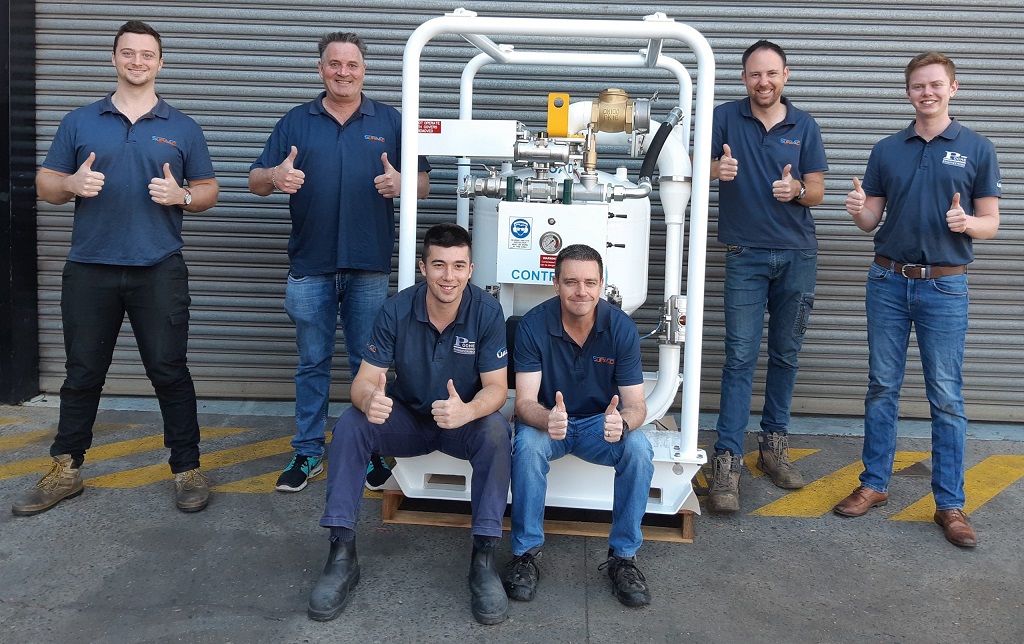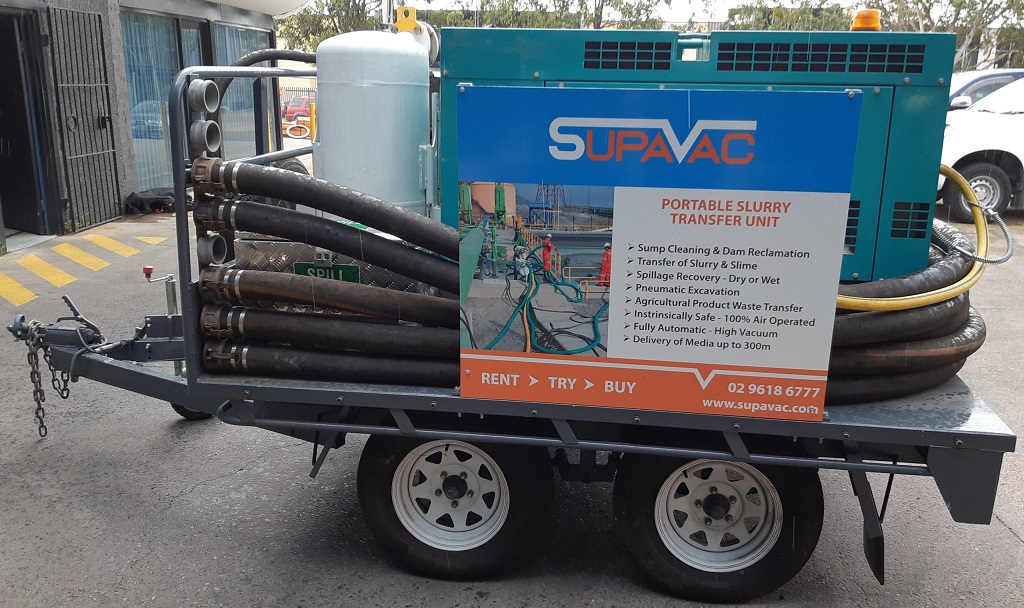The Australian Mining Review for SupaVac
Mine dewatering may be a standard requirement at mining operations across Australia and globally, but that doesn’t mean it’s always smooth sailing, often throwing up challenges depending on the materials involved.
When it comes to particularly thick slurries and high solids contents, traditional types of pumps including slurry, submersible, sump, air-operated diaphragm and helical rotor pumps simply cannot cope with the task.
Usually, this means bringing in expensive machinery or manual handling to deal with the issue. But there’s a better solution, according to SupaVac Global Sales Director Daniel De Groot. The SupaVac patented product range is owned and manufactured by an Australian precision engineering company, Poche Engineering.
Daniel said when traditional pumps are no longer able to handle the material, SupaVac pumps come into their own, handling thicker slurries and more solid material matter in a safer and more affordable system.
“Conventional centrifugal or rotor type pumps are all electrically or hydraulically driven, whereas SupaVac is 100 per cent air operated, so it uses compressed air which renders it intrinsically safe,” he said.
“When you’re looking at an operation like an underground coal mine, safety is a focus, so it’s a key advantage with SupaVac.”
- The SV60 used in an underground coal mine.
How the SupaVac Works
The pumping and material shifting process utilised by the SupaVac is deceptively simple, occurring in a cyclical motion making it not only safer, but also requiring less human intervention, according to Daniel.
“Basically, it uses a proprietary venturi,” he said. “The compressed air runs through that venturi, it expands and creates the vacuum, which draws the material into the vessel under low velocity.
“You’ve got the timer switches on there, so it switches from the suction cycle to the discharge cycle, where it will then switch valves over automatically.
“It then uses the compressed air as a pressure blanket on top of the material to push it down the discharge line under higher velocity keeping it in suspension to push it down the discharge line.”
As for how much solid matter a unit can pump, Daniel was certain of the SupaVac’s prowess.
“The more flowable the material is, the higher the transfer rate, but you can pump completely dry material as well,” he said.
“Typically, we say that solids can form about 70% of the suction and discharge of the pumps.
“The range starts at the SV30, which is a 50mm suction and discharge arrangement and then we go to the SV60 and SV60-V units which are 75mm.
“Then there’s the SV110 and above, right through to the SV510, which are all 100mm suction and discharge units, so by that point you’re looking at a unit that can deal with 75mm solids.”
The SV60-V is a one-person vacuum loading, pressure discharge pump capable of recovering and transferring up to 27 cubic metres per hour at SG1.0 of almost any flowable material.
It generates up to 25” Hg+ of vacuum combined with high airflow, which allows the unit to transfer materials ranging from mining slurries, solids and oil sludge through to cementitious powders and grains.
SupaVac in Underground Coal Operations
According to Daniel, the SV60-V is better for drier materials and most suited for offshore oil and gas rigs. It’s the SV60 that shines in the coal industry and other underground operations due to its lower dimensions.
“The SV60-V is vertical, whereas the SV60 is a horizontal model, giving it a lower centre of gravity and a capacity to accommodate the height restrictions you often find in an underground operation,” Daniel said.
The SV110 slurry and solids pump is a vacuum loading pressure discharge batch system that can recover up to 50m and deliver up to 500m while remaining a one-person or fully automatic operation.
It’s 100mm inlet and outlet, along with its conical tank design, make it a formidable tool for the removal of aggregate and mud slimes behind tunnel boring machines or continuous mining machines.
The larger, SV510 heavy duty solids pump was designed to transfer up to 45 cubic metres per hour of semi-viscous muds and various materials via vacuum load or top load gravity feed.
Like other SupaVac pumps, it possesses an ATEX Zone 2 and CE conformity approval rating.
Although the SupaVac has historically fit into a niche market, it has been used extensively in underground coal mines since the 1990s, where the name has become synonymous with any form of air-operated vacuum pump thanks to its use across the sector.
Daniel said while SupaVac could be used across varied operations its main application has been in coal fines recovery.
“The units have been used for recovering the coal fines and then putting it into the asset stream, also from any sumps or pits,” he said.
“All sorts of things can end up in a sump from bits of rope to used gloves and the unit will pass all of it; whatever fits in will get through.
“That’s because there are no internal moving parts, so there’s nothing to get stuck on.”
Daniel said the other big advantage of SupaVac pumps was that there are no wearing components inside the pump.
“There’s no wear on the vessel and the like, which is what people typically think will happen,” he said.
“Because there are no moving components, the pumps can run dry indefinitely.
“We’ve also got a range of air-operated float switches so that if the pump is at a low level it will actually switch the pump off and as the sump raises it will turn the pump back on automatically.
“That’s all pneumatically controlled and that helps the mine save money with their air consumption as well.”
- The SupaVac team and a SV250-400RF unit.
As for the SupaVac pump’s volume capacity, Daniel said it may be at the lower end compared to centrifugal systems, but the pumps still pack a punch and are the solution when other pumps can no longer pump the material.
“Our pumps are recovering the mess that someone else would have to deal with manually, so it’s typically low volume, but it’s far more effective than the alternative options which are manual handling or bringing expensive machinery,” he said.
“Depending on the hose length, solids consistency and the like, we’ll generally see the small pumps doing anywhere from two cubic metres per hour to 10 cubic metres per hour.
“Typically, in the mines the largest SupaVac we go to is the SV250 and on larger units like that with more solids-laden material that’s reasonably flowable, you might be getting up to 25 cubic metres per hour.”
This equates to about 50 trailer loads of material an hour, showing the capabilities of the SupaVac over excavators and other interventions when dealing with materials that traditional pumps are unable to tackle.
The SV250 mobile sludge pump is a vacuum loading pressure discharge system that can recover flowable slurries from up to 50m and deliver the same in excess of 1000m while remaining a one-person or fully automatic operation.
It can transfer more than 40 cubic metres per hour at SG1.0 depending on application requirements.
Designed to transfer an extremely wide array of heavy sludges via 100mm suction and discharge lines, the SV250 can operate with various Jet Packs ranging from 150cfm to 750cfm depending on specific application requirements.
- A SupaVac SV60-V rental trailer unit with computer and accessories.
Looking to the Future
Although the SupaVac range was developed in 1993, Poche Engineering is determined to continue developing innovations for current and future markets.
“Through Poche Engineering, we have been reinvigorating the product and working on new product development,” Daniel said.
“We brought in the new smaller SV30 and larger SV510 pumps in 2020.
“With the technology, the pneumatics on the units that we’ve had since the product was developed in the early 1990s, we’re actually just finishing off the next generation of pneumatic controls for the unit, which will make them more user friendly while increasing safety, useability and serviceability.”
Daniel said Poche Engineering was looking to move beyond simply supplying pumps by developing a complete system.
“A team of engineers have been looking at developing complete systems and working on a coal fines recovery system, which recover the coal fines, then dewater them and put them back on the conveyor belt,” he said.
“We’re evolving into a bespoke solution designer where we provide a complete system for mining operations facing situations where they otherwise would have had to bring in expensive machinery.”
Poche Engineering also currently offers a rental fleet of units, including a trailer-mounted unit with the compressor fitted and ready to go.
With its headquarters in Ingleburn, NSW, Poche Engineering has been in operation for more than 80 years.
It has expanded to employ more than 40 people across multiple sites, supplying to mining operations across Australia and the world.








